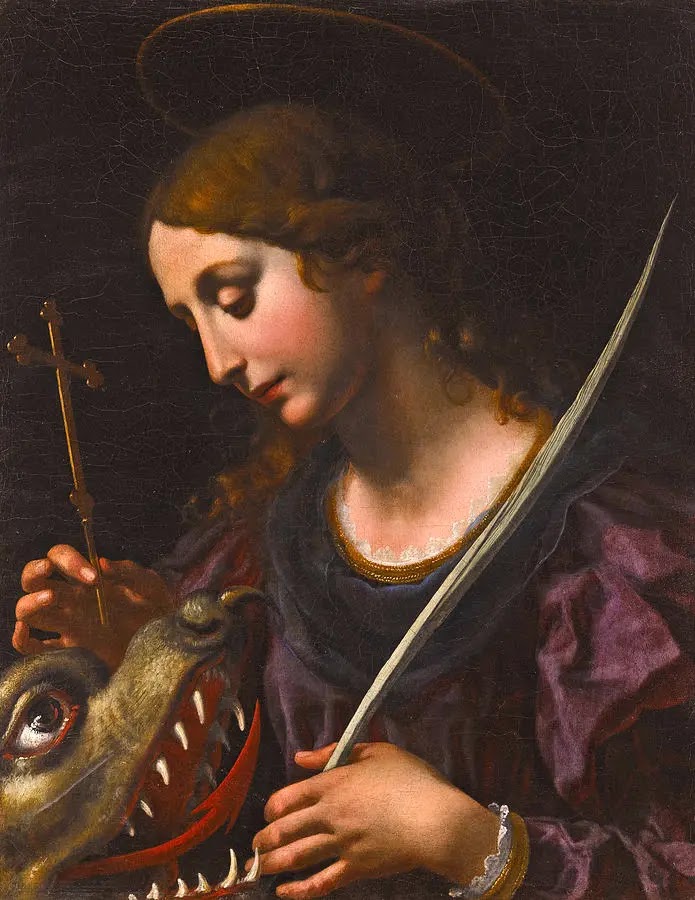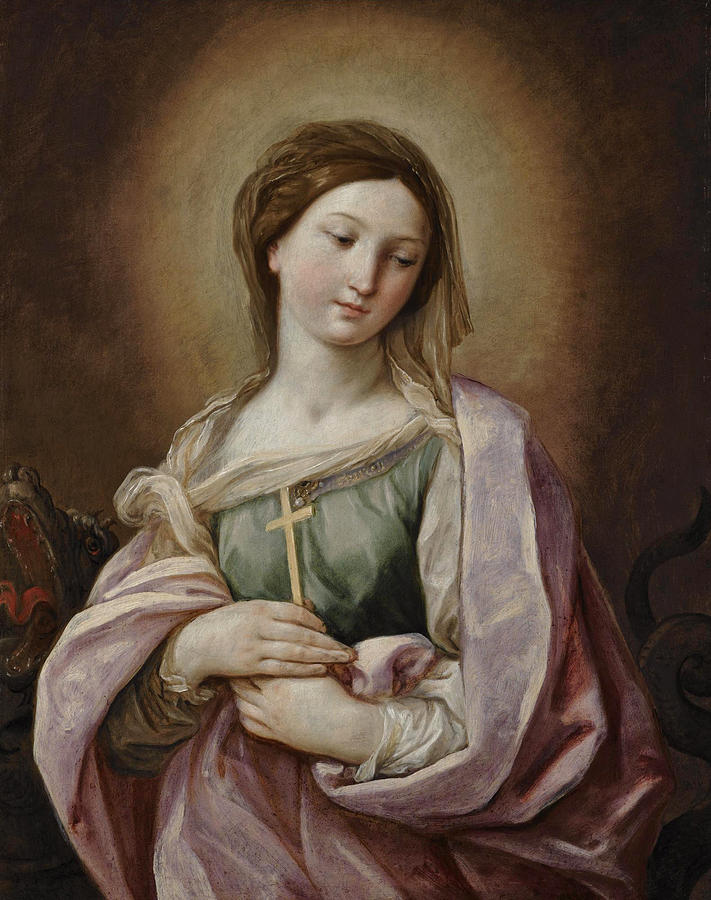MARGARET, POWERFUL PATRONESS OF THE PREGNANT
Margaret of Antioch was a Syrian Saint who lived during the brutal reign of Emperor Diocletian (284 - 305). We know from how Diocletian orchestrated the martyrdom of St Philomena that he had quite a thing for chopping off the heads of beautiful young women who could not be forced into marriage against their will. Diocletian had a neck as thick as a tree-stump, and under his rule, there was a judge, Prefect Olybrius who brought St Margaret up on charges of being a Christian and sought to use the law to punish her, well he said this was the reason he persecuted her...
Prefect Olybrius came upon young Margaret one day when she was tending sheep. She served as a shepherdess to the woman who saved her from the streets. Margaret's biological father was a pagan priest who utterly rejected his daughter after she spurned paganism and was baptized. Her mother had died when she was an infant, and so Margaret had no mother around to remonstrate with her father for his rash renunciation of her. The nurse her father had employed to care for her as a babe in arms was the one who brought Margaret to Faith and gave her shelter when she was thrown out of home. In return, Margaret herded her nurse's sheep.
Margaret was a ravishingly beautiful woman and after she caught the eye of Prefect Olybrius, he wanted to make her his mistress or wife. He tried to woo her with platitudes and also threats of retribution, but she could neither be flattered or coerced. At a public trial, she was convicted of being a Christian and first they tried to burn her alive, but miraculously the flames did not touch her. Then she was bound in ropes and flung into a huge kettle of boiling water. The water, however, did not boil her to death, instead the ropes were snapped and she stood up in the bubbling bath and looked perfectly well and lovely. T'was a good thing that the fire had not reduced her body to ash and that the water had not cooked her to a piece of bloated meat because that would have caused her body to disintegrate completely before a Christian burial could take place. Instead, she died when her head was cut clean off. In the centuries that followed, Margaret became known as a grand helper of pregnant women.
It has baffled some that from antiquity to modern times, Margaret has been upheld as a special intercessor for women who are with child. They ask why would a virgin-martyr who refused to become a mother enjoy such a celebrated reputation as one who gives miraculous help to pregnant women? Margaret has earned this fame, and some years ago when I wrote about her for The Catholic Herald, I myself was surprised that people were in touch to say that their prayer to her had meant they had overcome severe problems in pregnancy. Indeed, Margaret graduated to being counted among the Fourteen Holy Helpers.
The fact that Margaret never entered a relationship where pregnancy was a possibility for her - she never became a girlfriend and never became a wife - does not disqualify her from being a great friend to pregnant women. While she did not know the lived experience of having a babe in her womb, we need bear in mind that Margaret's mother died shortly after giving birth to her and thus Margaret knew motherlessness, perhaps because her mother had a hard pregnancy and labor from which she did not heal. Margaret carried inside her a visceral feeling that those in troubled pregnancies need help lest they leave their baby without a mother as she was left. This prompted Margaret to have a soul that sought to support women who find themselves in the same jeopardy as her mother.
Margaret has always sought to be the heavenly helper to expectant mothers, a helper that her mother did not have.
* * *
The classics painting of St Margaret of Antioch were executed by Onorio Marinari and Guido Reni.




.jpg)
Funny you don't say anything about the monster / dragon in her portrait! These paintings are not of St Margaret, but of St Martha, who, after persecution in the Holy Land, supposedly drifted to Gaul (France) in a boat with her brother Lazarus and sister Mary.
ReplyDeleteThere, they found a town afflicted by a dragon /monster called "Tarasque". St Martha conquered/ tamed (?) the dragon by her humility and faith, (just how, I do not know) and the place became known as modern town of Tarascon. Look up her legend, perhaps in the online Catholic Encyclopedia.
I happen to have hanging on the wall a medieval brass rubbing of St Martha and the dragon (which seems to behave like an ugly pet) so that is how I know this is not a picture of St Margaret of Syria, who didn't have a French dragon. :-)
With all due respect, the paintings that accompany my post are not of St Martha. Both are of St Margaret of Antioch. The first painting was executed by Onorio Marinari and if you look up Artory, they show details of the sale. I think they'd be pretty miffed if they found out that this valuable Baroque painting was not of Margaret. Also, if you look up Sotheby's, you will see that Guido Reni's Margaret of Antioch (the second painting used in my post) was auctioned for 506, 500 USD. I think it would be quite the clanger if they'd mistaken Martha for Margaret.
DeleteThank you for letting me know of Martha, Mary and Lazarus's travels to France. I will surely look into this. Love, Mary
It wouldn't be the first time art galleries and auction houses (whose employees are rarely knowledgable Catholics have made howling mistakes in identifying portraits or statues because they are unfamiliar with the saints' symbols or iconography. When I lived in Houston (I now live in the UK) The first time I went through a large antiques emporium on Heights Boulevard at 8th street one time, reading the tags mislabeling several statues of (admittedly obscure) saints all in one large room. I got so fed up that I politely fetched the owner and offered to tell him their correct names. The (non-catholic) guy was very nice, and came with me as I helped him re-label fully 1/3 of his statues. Turns out he bought these from auction because he "felt sorry" for them, discarded from sold-off churches. He sold to people setting up "prayer closets" and "prayer sheds" and I told him that God would reward him for his care of these images of His friends, and he laughed and said that's how he regarded them, friends, and would not sell to people he felt were evil. I worked for an artist for some years; have a Catholic friend here in the UK who used to work for Sotheby's, and I know how poorly sometimes galleries and auctions mis-identify images of saints. I taught a course one time in Houston at the Ordinariate Cathedral on Spring Branch on the symbols and iconography of the saints, especially in the Middle Ages. Best wishes, --Adrian Johnson
Delete